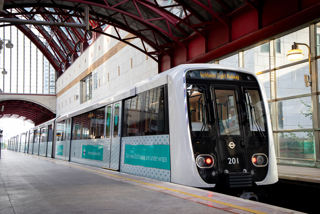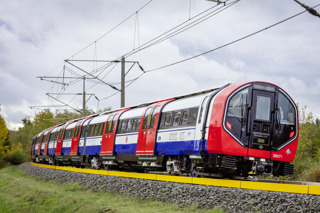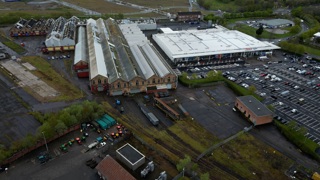At 2308 on Friday March 8 1996, a short distance south from the point where the West Coast Main Line diverges at Stafford into its Birmingham and Trent Valley routes, a Mossend-Willesden freight train operated by Transrail was making its way southbound towards Wolverhampton.
A defective axle caused ten of its 23 wagons to derail either side of the track, sending two of them tumbling into the path of a Birmingham to Glasgow Travelling Post Office (TPO) train travelling in the opposite direction.
Amid the tangled wreckage, it is hard to believe now that the death toll was not much higher (one person died). And it easily could have been, had the TPO’s locomotive not mercifully come to rest on a bank just inches short of the side of a row of houses. Residents of adjacent cul de sac The Russetts, unaware of just how fortunate they’d been, emerged to a thick cloud of gas as several wagons laden with liquid carbon dioxide emptied their contents across the crash site.
Transrail had been acquired from British Rail only weeks earlier by Wisconsin Central Transportation, as part of the privatisation of all BR’s freight operations. Initial crash reports and the subsequent investigation were to raise serious questions over standards for wagon maintenance, throwing the decision by John Major’s government to privatise the railways firmly back under the spotlight of public scrutiny.
At the time, the crash was the most serious to occur since Railtrack had assumed responsibility for rail infrastructure from BR in 1994. And it was just two months before it was opened up to private investors on the stock exchange. Critics of privatisation would go on to portray Rickerscote as an example of why taking the railways out of public ownership was (in their view) to the detriment of safety and maintenance.
On that fateful day, the Transrail freight had left Mossend Yard near Glasgow at 1440, arriving at Warrington Arpley Yard at 2038. Here it was routinely examined by the duty Rolling Stock Technician, who found nothing of concern. Made up of 23 wagons hauled by two Class 37s (37071, 37207), it passed a lineside hot axle box detector just north of Stafford at 2255, which detected nothing amiss.
Meanwhile, heading north was a TPO operated by Rail Express Systems, also recently acquired by Wisconsin Central Transportation. Hauled by a Class 86 (86239), it comprised nine Mk 1 Royal Mail parcel vans and sorting carriages. It had been driven empty from London Euston to Coventry, where mail was loaded and six Royal Mail employees joined the train. A further stop was made at Birmingham New Street for mail and to pick up an additional 14 sorting staff.
At 2304 the Transrail freight cleared Trent Valley Junction and accelerated under clear signals along the Up Fast. At the point where the line is joined by the Up Slow Birmingham line (and where three lines converge into two), the driver noticed his train’s air brake apply automatically, bringing it from 35mph to a stop.
Travelling northbound, the TPO’s driver Graham Massey was braking from 90mph to comply with the 60mph speed restriction at Trent Valley Junction when he saw a dark object appear in front of him on his track.
Seconds later, the force of the collision split the freight train into three portions. The two locomotives and leading eight wagons did not derail and suffered little damage, but the following eight were strewn across the line.
One had contained aviation fuel, but was fortunately empty. The other seven were filled with pressurised carbon dioxide, now leaking as a thick white pall across the shallow cutting. Two wagons loaded with starch lay derailed to the rear, while the final five remained upright and on the tracks.
The TPO’s Class 86 absorbed much of the impact as it was forced up the bank and onto its side, its leading edge almost touching the end wall of a terraced set of houses in The Russetts. The following four coaches concertinaed together and lay astride the two tracks, while the remaining five managed to stay in position.
For the postal workers, many of whom were on their feet as they busily sorted mail, the crash threw them across carriages or down their entire length, inflicting cuts, bruises and whiplash injuries. Remarkably, Driver Massey was able to crawl to safety through the side window of his cab, despite suffering a broken leg and severe pelvic injuries.
The worst damage was sustained by the brake van located immediately behind the locomotive - it was compressed by its front end colliding with derailed freight wagons and by its rear being badly crushed by the force of the second carriage piling into it. The second carriage was also severely damaged, its momentum smashing its toilet and recreational area against other scattered wagons.
Nine members of staff were in the third carriage taking a tea break. One suffered a fractured skull and another a fractured shoulder. The remaining workers in coaches five and six escaped with less serious injuries, as the vehicles remained upright and intact.
Tragically 57-year-old postal worker John Thompson did not survive the impact - he was found in the gangway area between coaches one and two, which had suffered the worse degree of compression.
The freight train driver, unharmed by the crash, climbed down from his locomotive and walked to the rear of the train, quickly discovering that only eight wagons were still attached.
In the dead of night, he was able to make out the rear of the TPO in the darkness and hear the loud hissing sound of gas escaping the wagons, but could not visibly appreciate the scale of destruction to the two trains.
Being close to a signal equipped with a telephone, he immediately contacted the signaller at Stafford No. 4 signal box, informing him that his train was divided and emergency services were required. Returning to his cab he made an emergency call from the cab radio to the Railtrack Control Office at Crewe, before placing track circuit operating clips and detonators on the line to change all signals to red and protect the rears of both trains.
The signaller was unable to contact emergency services by dialling 999, as lineside cables had been severed by the derailment. He instead called the supervisor at Stafford station via British Rail’s internal phone system.
Despite these initial problems, two Fire Service appliances reached the scene just four minutes after receiving the call at 2311.
First responders were met by a dense white cloud of carbon dioxide leaking from the pierced wagons, but the injured were quickly located and moved to waiting ambulances by fire fighters wearing breathing apparatus. The Fire Service was given confirmation that the gas was carbon dioxide by the driver of the freight train, and by the Train List that recorded the wagons carrying dangerous goods and their position in the train.
Although not a toxic substance and non-flammable, the gas was sufficiently concentrated to induce unconsciousness in one bystander through oxygen deprivation, before that evening’s light wind was able to slowly disperse it. More than 50 homes were evacuated until the remaining carbon dioxide could be drained from all wagons conveying the gas.
A full inquiry to establish the cause of the fatal crash was rapidly launched by the Health & Safety Executive (HSE), and inspectors from HM Railway Inspectorate focused on a defective axle found beneath the ninth wagon, owned by CAIB UK and leased to MG Gas Products.
Railtrack controversially issued a statement within hours of the collision stating that no evidence of track defects, vandalism or signalling could be found, drawing strong criticism from Labour’s transport spokesman Brian Wilson for absolving itself of blame before causation could reasonably be ascertained.
Published on November 4 1996, the HSE report confirmed that the track in the Rickerscote area had indeed been in good condition and that the broken axle had induced the crash, stemming from a rare type of fracture in the broken axle’s mid-span.
The point of derailment was located 800 metres from where the freight train’s leading locomotive had come to a stand. Damage to the railheads and sleepers indicated that a wheel had fallen into the space between the running rails and had ridden over track fastenings for 323 metres. From this point damage was also visible on the inside of the other rail, indicating that a corresponding wheel had also dropped down from the railhead.
Where the Up Slow Birmingham line joins the Up Fast line the components became jammed in the space between the two converging rails and were ripped free, causing the derailment of the ninth wagon and several of those behind. Most wagons derailed fairly harmlessly towards the left hand side in the direction of travel and the embankment, but the ninth and 14th of the formation derailed towards the right, and therefore foul of the Down Fast line.
At some stage the through brake pipe was severed causing the brakes on the freight train to apply automatically, prompting the driver to investigate the collision unfolding behind him.
The cause of the fracture proved harder to determine, but following examination by British Rail Research at its Derby laboratories, it was attributed to metal fatigue initiated by corrosion pitting on the axle’s surface. However, the axle ends suffered considerable damage when the fracture occurred, destroying much of the direct evidence.
The investigation found that the failed axle had been maintained broadly in line with long-established industry standards that were not affected by the privatisation of the railways, despite three parties (Railtrack, CAIB UK and MG Gas Products) all now holding some responsibility for the vehicle being in a safe condition (rather than British Rail as a single track and rolling stock owner/operator under the previous regime).
The HSE went on to highlight the different standards of maintenance in operation for railway vehicles sold by BR to large railway operators such as EWS, Transrail and Freightliner, and those standards applied to rolling stock owned by smaller private owners such as CAIB UK.
This system was largely inherited by Railtrack from BR, but meant that Railtrack was unable to confirm if all wagons on its network were up-to-date with their maintenance schedules.
This formed the HSE’s key recommendation that Railtrack harmonise its Group Standards so that all vehicles using the network are maintained to the same standard, and recorded using a single system.
Ten other recommendations were made to better understand the mechanism of fatigue crack growth (which was not well understood in 1996), and to investigate potential changes to the axle testing regime, including submitting wagons for testing at more frequent intervals. The HSE also asked Railtrack to look at the value of examining axles that failed tests (previously they had often been discarded), and to collate and analyse the results from rejected axles.
Railtrack was also requested to remind its staff of the need, in the event of a crash, for early transfer to the emergency services of information on dangerous goods being carried - fortunately this had been nothing more harmful than carbon dioxide in the case of Rickerscote.
It also had to review its incident management procedures, in light of the signalman’s difficulties in alerting the emergency services, and some confusion caused when the Fire Service was handed a list of mail train staff that included the names of those who had not yet boarded and were still waiting at Crewe.
Railtrack set up the Rickerscote Steering Group in association with railway vehicle operators in January 1997, to progress all 11 of the HSE’s recommendations.
Rickerscote may be less infamous than crashes that followed in the years immediately after and which resulted in a greater loss of life, such as at Ladbroke Grove (1999) and Hatfield (2000). But it did come first, and thus marks the beginning of Railtrack’s ignominious slide towards administration six years later, when confidence in its ability to safely administer the railways had finally been diminished.
- This feature was published in RAIL 795 on March 2 2016

















Login to comment
Comments
No comments have been made yet.